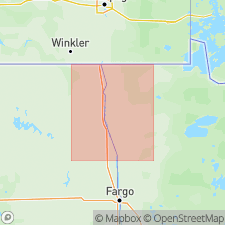
- Usage in publication:
-
- Marcoux Formation
- Modifications:
-
- Original reference
- Dominant lithology:
-
- Sand
- Silt
- Clay
- Cobbles
- Boulders
- AAPG geologic province:
-
- Sioux uplift
- Williston basin
Summary:
Pg. 5 (fig. 2), 7 (fig. 3), 9-10, 30-31, 33-34 (measured sections). Marcoux Formation. Light-gray and grayish brown, unbedded, very sandy pebble-loam; sand (48 to 58 percent), silt (30 to 40 percent), and clay (8 to 18 percent). Contains abundant pebbles, cobbles, and boulders, of mostly igneous and metamorphic rock types. Weakly jointed. Exposed thickness 6 inches to 27 feet. Overlies Gervais Formation (new) and underlies St. Hilaire Formation (new); contacts are sharp. In weathered outcrops it is extremely hard and stands in nearly vertical slopes; rapids in Red Lake River are generally associated with the Marcoux. Unit is difficult to penetrate in subsurface due to hardness and large number of boulders. Believed to extend from north of Canadian border into northwestern Minnesota and eastern North Dakota. Deposits interpreted as glacial sediment; predominance of granitic and metamorphic rock types suggests the Marcoux was deposited by a glacier advancing from the northeast across the Canadian Shield. Age is considered late Pleistocene (early Wisconsinan or pre-Wisconsinan), based on stratigraphic position.
Source: Publication.
For more information, please contact Nancy Stamm, Geologic Names Committee Secretary.
Asterisk (*) indicates published by U.S. Geological Survey authors.
"No current usage" (†) implies that a name has been abandoned or has fallen into disuse. Former usage and, if known, replacement name given in parentheses ( ).
Slash (/) indicates name conflicts with nomenclatural guidelines (CSN, 1933; ACSN, 1961, 1970; NACSN, 1983, 2005, 2021). May be explained within brackets ([ ]).

